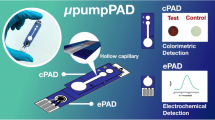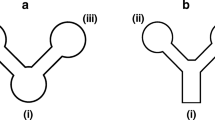Abstract
We report the use of paper-based microfluidic devices fabricated from a novel polymer blend for the monitoring of urinary ketones, glucose, and salivary nitrite. Paper-based devices were fabricated via photolithography in less than 3 min and were immediately ready for use for these diagnostically relevant assays. Patterned channels on filter paper as small as 90 μm wide with barriers as narrow as 250 μm could be reliably patterned to permit and block fluid wicking, respectively. Colorimetric assays for ketones and nitrite were adapted from the dipstick format to this paper microfluidic chip for the quantification of acetoacetate in artificial urine, as well as nitrite in artificial saliva. Glucose assays were based on those previously demonstrated (Martinez et al., Angew Chem Int Ed 8:1318–1320, 1; Martinez et al., Anal Chem 10:3699–3707, 2; Martinez et al., Proc Nat Acad Sci USA 50:19606–19611, 3; Lu et al., Electrophoresis 9:1497–1500, 4; Abe et al., Anal Chem 18:6928–6934, 5). Reagents were spotted on the detection pad of the paper device and allowed to dry prior to spotting of samples. The ketone test was a two-step reaction requiring a derivitization step between the sample spotting pad and the detection pad, thus for the first time, confirming the ability of these paper devices to perform online multi-step chemical reactions. Following the spotting of the reagents and sample solution onto the paper device and subsequent drying, color images of the paper chips were recorded using a flatbed scanner, and images were converted to CMYK format in Adobe Photoshop CS4 where the intensity of the color change was quantified using the same software. The limit of detection (LOD) for acetoacetate in artificial urine was 0.5 mM, while the LOD for salivary nitrite was 5 μM, placing both of these analytes within the clinically relevant range for these assays. Calibration curves for urinary ketone (5 to 16 mM) and salivary nitrite (5 to 2,000 μM) were generated. The time of device fabrication to the time of test results was about 25 min.

Paper-based microfluidic chip illustrating the colorimetric detection of salivary nitrite. Color intensities were quantified using a flatbed scanner and image manipulation software and plotted against concentration to produce calibration curves for the assay









Similar content being viewed by others
References
Martinez AW, Phillips ST, Butte MJ, Whitesides GM (2007) Angew Chem Int Ed 8:1318–1320
Martinez AW, Phillips ST, Carrilho E, Thomas SW, Sindi H, Whitesides GM (2008) Anal Chem 10:3699–3707
Martinez AW, Phillips ST, Whitesides GM (2008) Proc Natl Acad Sci USA 50:19606–19611
Lu Y, Shi W, Jiang L, Qin J, Lin B (2009) Electrophoresis 9:1497–1500
Abe K, Suzuki K, Citterio D (2008) Anal Chem 18:6928–6934
Martinez AW, Phillips ST, Wiley BJ, Gupta M, Whitesides GM (2008) Lab Chip 12:2146–2150
Ellerbee AK, Phillips ST, Siegel AC, Mirica KA, Martinez AW, Striehl P, Jain N, Prentiss M, Whitesides GM (2009) Anal Chem 20:8447
Lu Y, Shi W, Qin J, Lin B (2009) Anal Chem 1:329
Carrilho E, Martinez AW, Whitesides GM (2009) Anal Chem 16:7091
Li X, Tian J, Nguyen T, Shen W (2008) Anal Chem 23:9131
Carrilho E, Phillips ST, Vella SJ, Martinez AW, Whitesides GM (2009) Anal Chem 15:5990
Fischbach F, Dunning MB (2009) A manual of laboratory and diagnostic tests, 8th edn. Wolters Kluwer Health, Philadelphia
Sherman RA, Swartz RD, Thomas C (2006) Treatment methods for kidney failure: hemodialysis. http://www.kidney.niddk.nih.gov/kudiseases/pubs/hemodialysis/ 08/18/2009
Griffiths GS (2003) Periodontol 1:32–42
Blicharz TM, Rissin DM, Bowden M, Hayman RB, DiCesare C, Bhatia JS, Grand-Pierre N, Siqueira WL, Helmerhorst EJ, Loscalzo J, Oppenheim FG, Walt DR (2008) Clin Chem 9:1473–1480
Brooks T, Keevil CW (1997) Lett Appl Microbiol 3:203–206
Yildirmaz G, Akgöl S, Yakup ArIca M, Sönmez H, Denizli A (2003) React Funct Polym 2:103
Laios ID, Pardue HL (1993) Anal Chem 14:1903
Silberberg C (2007) Ketones—urine. http://www.nlm.nih.gov/medlineplus/ency/article/003585.htm
Sun J, Zhang X, Broderick M, Fein H (2003) Sensors 8:276–284
Acknowledgment
Funding for this research was made possible through the National Science Foundation (NSF CAREER Award CHE-0548046).
Author information
Authors and Affiliations
Corresponding author
Additional information
Scott A. Klasner, Alexander K. Price and Kurt W. Hoeman made equal contributions to this work.
Electronic supplementary material
Below is the link to the electronic supplementary material.
ESM 1
(PDF 462 kb)
Rights and permissions
About this article
Cite this article
Klasner, S.A., Price, A.K., Hoeman, K.W. et al. Paper-based microfluidic devices for analysis of clinically relevant analytes present in urine and saliva. Anal Bioanal Chem 397, 1821–1829 (2010). https://doi.org/10.1007/s00216-010-3718-4
Received:
Revised:
Accepted:
Published:
Issue Date:
DOI: https://doi.org/10.1007/s00216-010-3718-4




